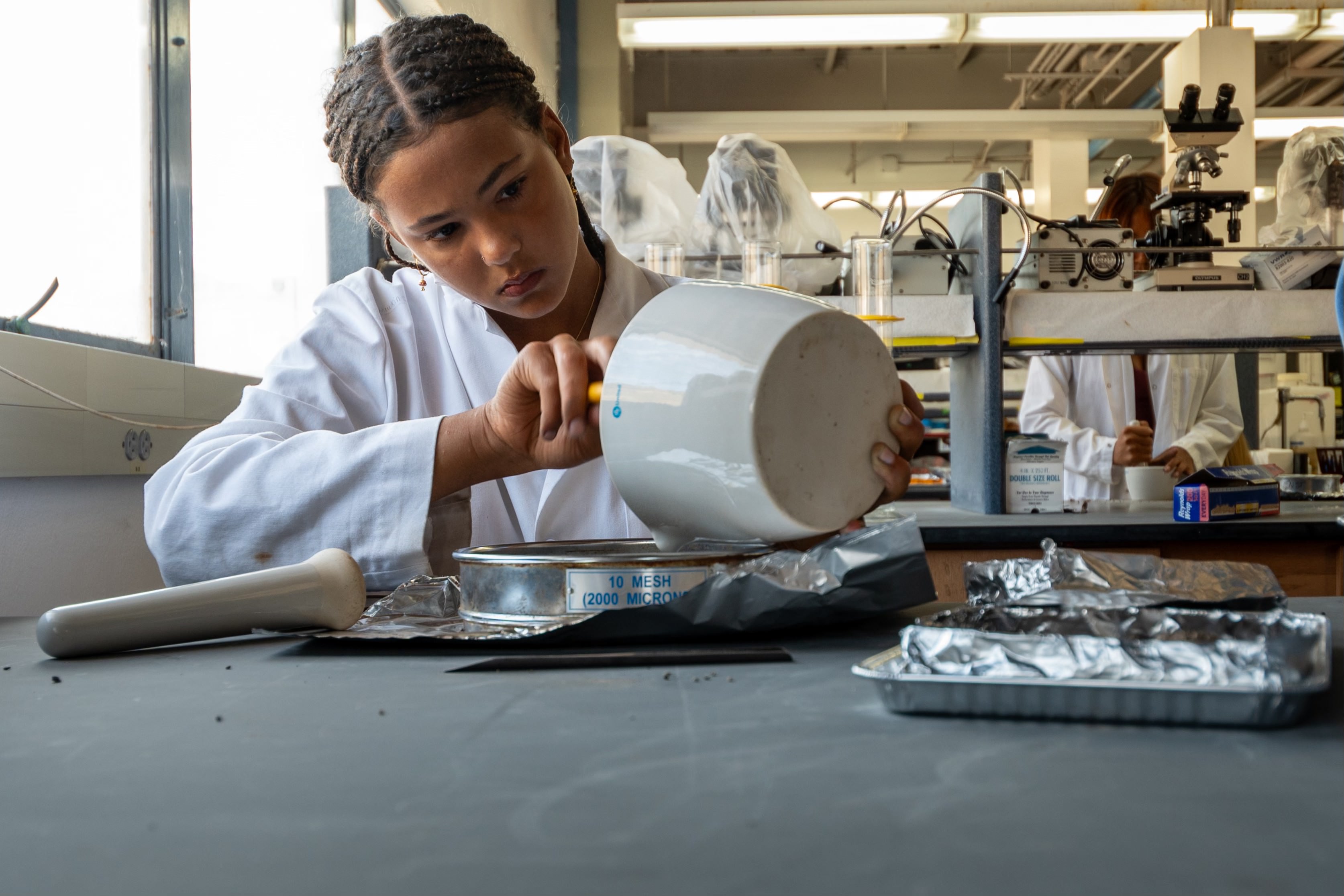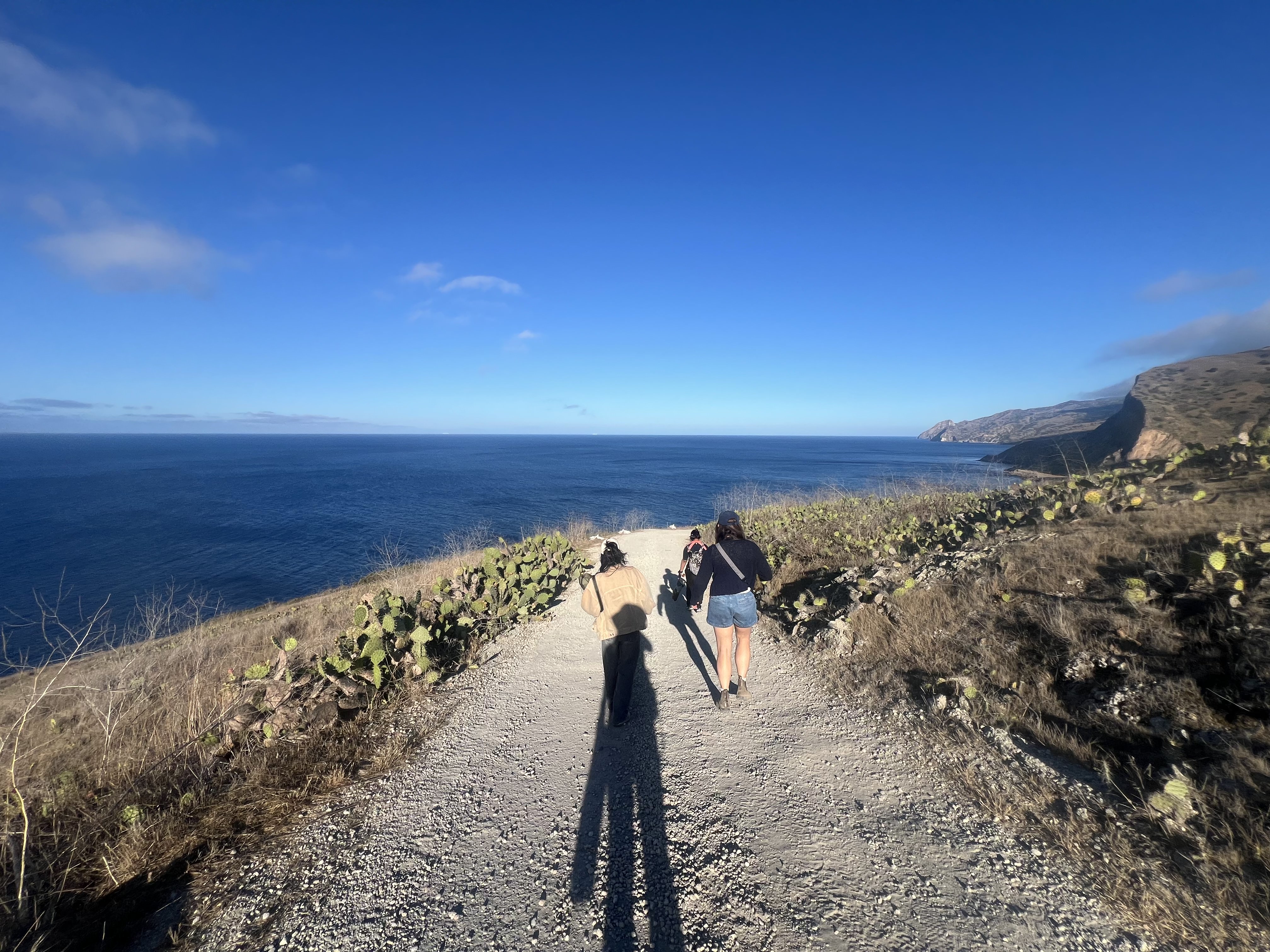
UNDER PRESSURE
Catalina Island Test Plot
By: Alex Robinson
DATE: September 10 2025
Traveling to Catalina Island, or nearly any of the islands off the coast of Southern California, can be an exercise in time travel. For a resident of the mainland bight, it is a multi-threaded journey. Yes, time goes back, rhythms slow, but time also jumps ahead and sideways. The day I visited the Test Plot at the Wrigley Marine Science Center, had a touch of foreshadowing. After our indeterminably long and late hot summer, I enjoyed what everyone agreed, was the first day of Fall, weeks ahead of the mainland.
Talks of cutting back and layoffs were in the air. In the wake of our president’s agenda, research money was drying up and USC was looking to cut research-related staff on the island, many of whom rely on their job to maintain residence on an island mostly owned by either the Catalina Company or Conservancy.
Due to a mild but persistent drought, the plants in this Test Plot have subsisted only by rain and water harvested in rain barrels around the campus. While the channel concentrates moisture, it also bakes, sheltered from coastal breezes by the surrounding dorms. The drought has reduced forage on the island, inducing (introduced) deer and the native squirrels especially to munch the plants. The delicious ones are “topiared” into the shape of their protective steel cages, if they are so lucky to have one.
After this year’s devastating fires, the fire department reassessed all building adjacent plantings. Now nearly all the plants we had planted were “trespassing.” If they had their way they would clear all vegetation within a 100 feet of all structures.


As I conducted my inventory, I could see and feel the pressures on the plot that its steward had skillfully been deflecting. As many islands are, Catalina is small, isolated, and exposed; it is simultaneously a place apart and precariously sensitive to ecological and political turbulence. Yet, thanks to her determined care, the plants are hanging in there and even thriving. The native milkweed has spread out triumphantly, shimmering in the sunlight, and seeding itself. The Catalina Ironwood, my favorite, was both being munched and had flowered, even though its planting pit had required an electric spade to excavate. Mugwort and Tule, two water loving species, were happy behind the check dams, we assembled two years ago. Many small plants, ones you would expect to be the first to go, were hanging on: yarrows, buckwheats, and Yerba Buena. The Catalina Manzanita was making a surprising sprint to its tree form.
All in all, perhaps more than 85% of the plants had survived. Casualties included the ever lovely St Catherine’s Lace buckwheat and the dudleyas, that while alive, had been nibbled to nubs. (All the plants were donated by the Catalina Conservancy over the last two years.)
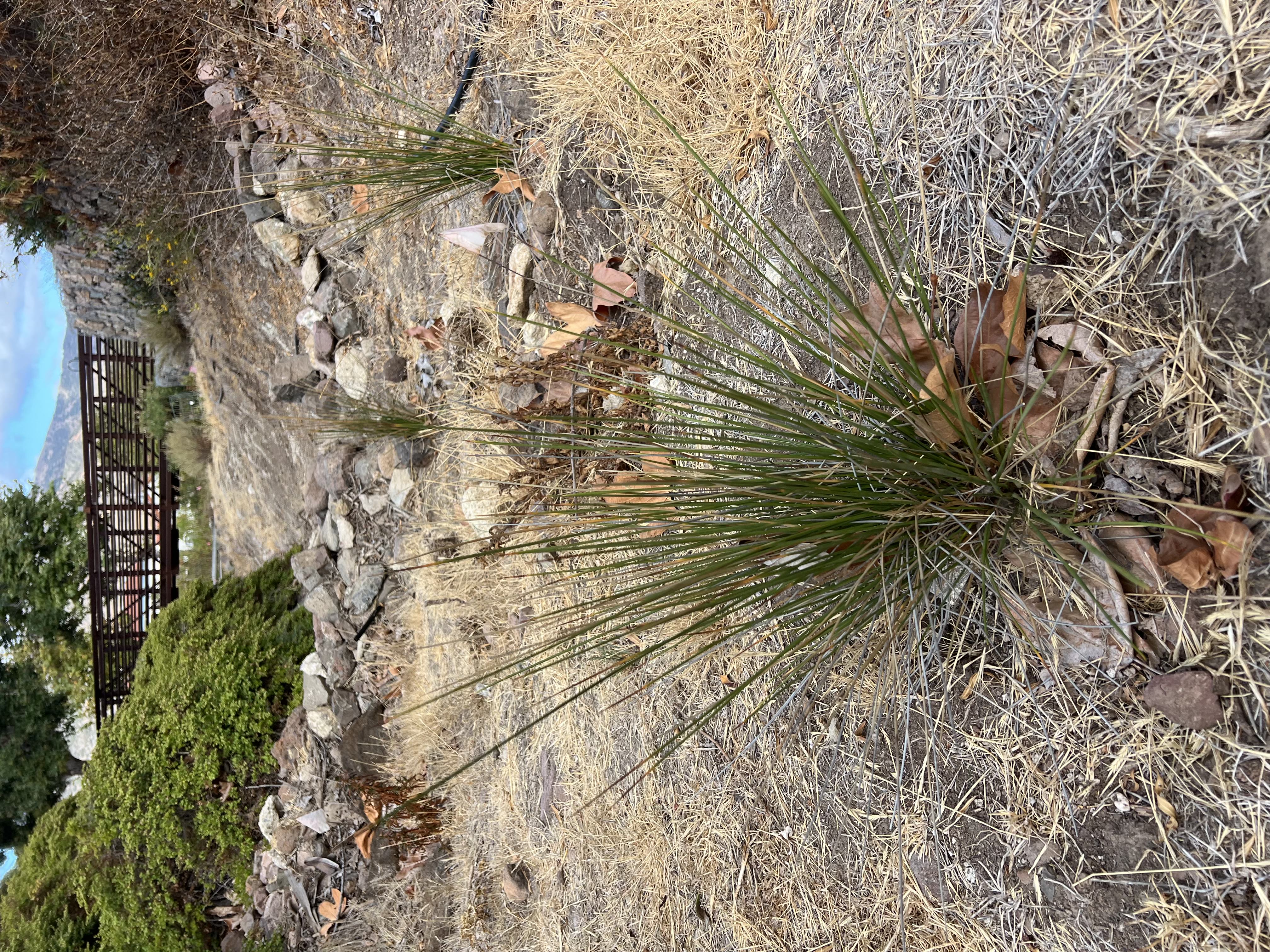
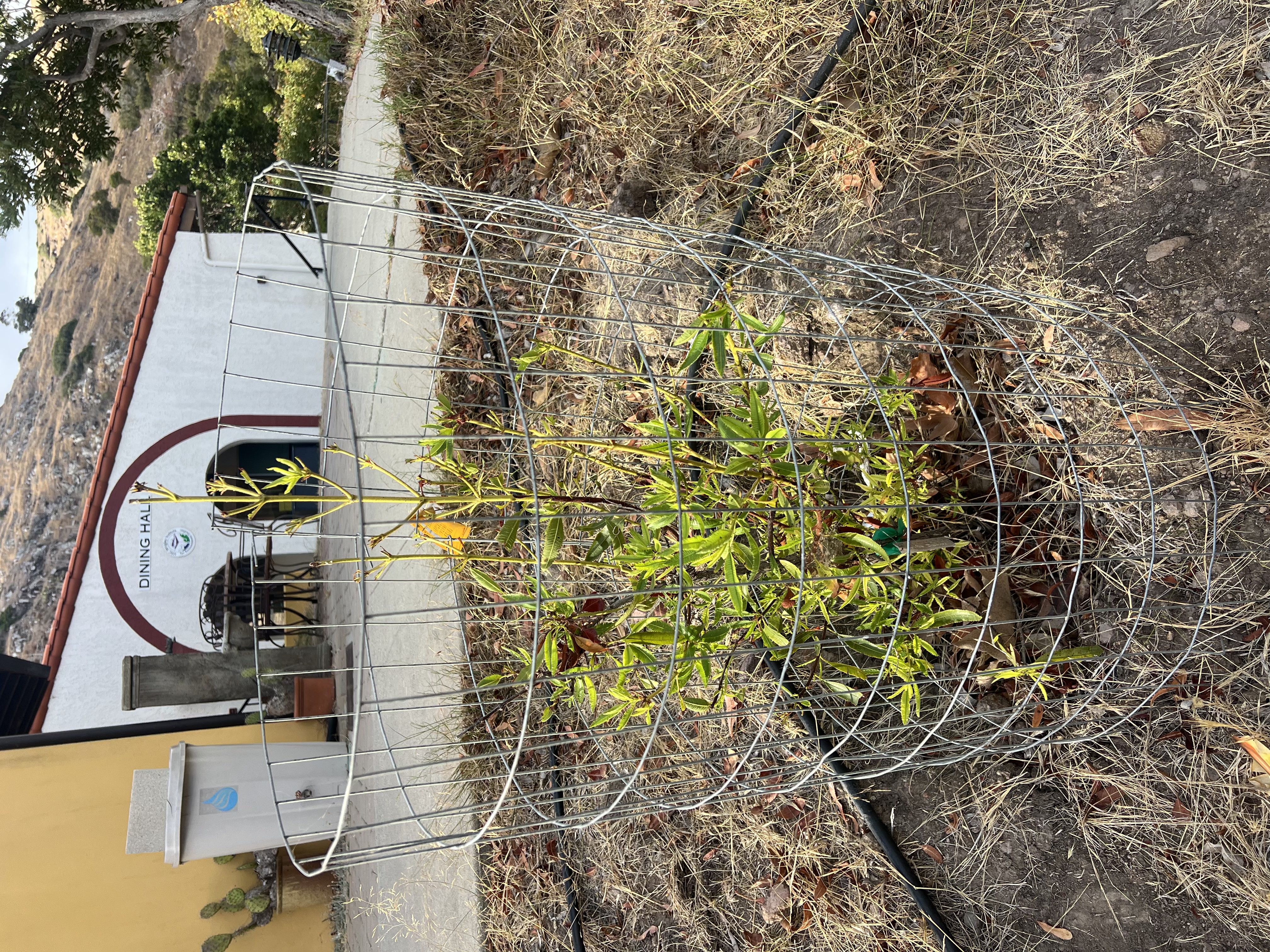
What is the future of this plot and its plants? Of this island and research station? More than most years, it is in flux.
Some of the pressures may subside. There is a plan to remove the deer from the island, that may actually be implemented; it would come with divisions and trauma, but would bring back biodiversity and radically improve all future restoration efforts.
Meanwhile, I wonder whether our island steward will survive the cuts. I worry for her and I worry for this plot. The whole situation speaks to how much persists by the constant care of steward(s). They are needed to manage the pressures, but here we can see limits, however complex. The fate of the plants and the people are precariously entangled, and particularly on this outpost. In ways they tell us how to care: when to care for each and when we must tackle the pressures themselves.
I finished my plant inventory and went down to jump in the water. Later I headed back to the mainland on the Miss Christi USC boat. A few weeks later I heard our local steward would be laid off.
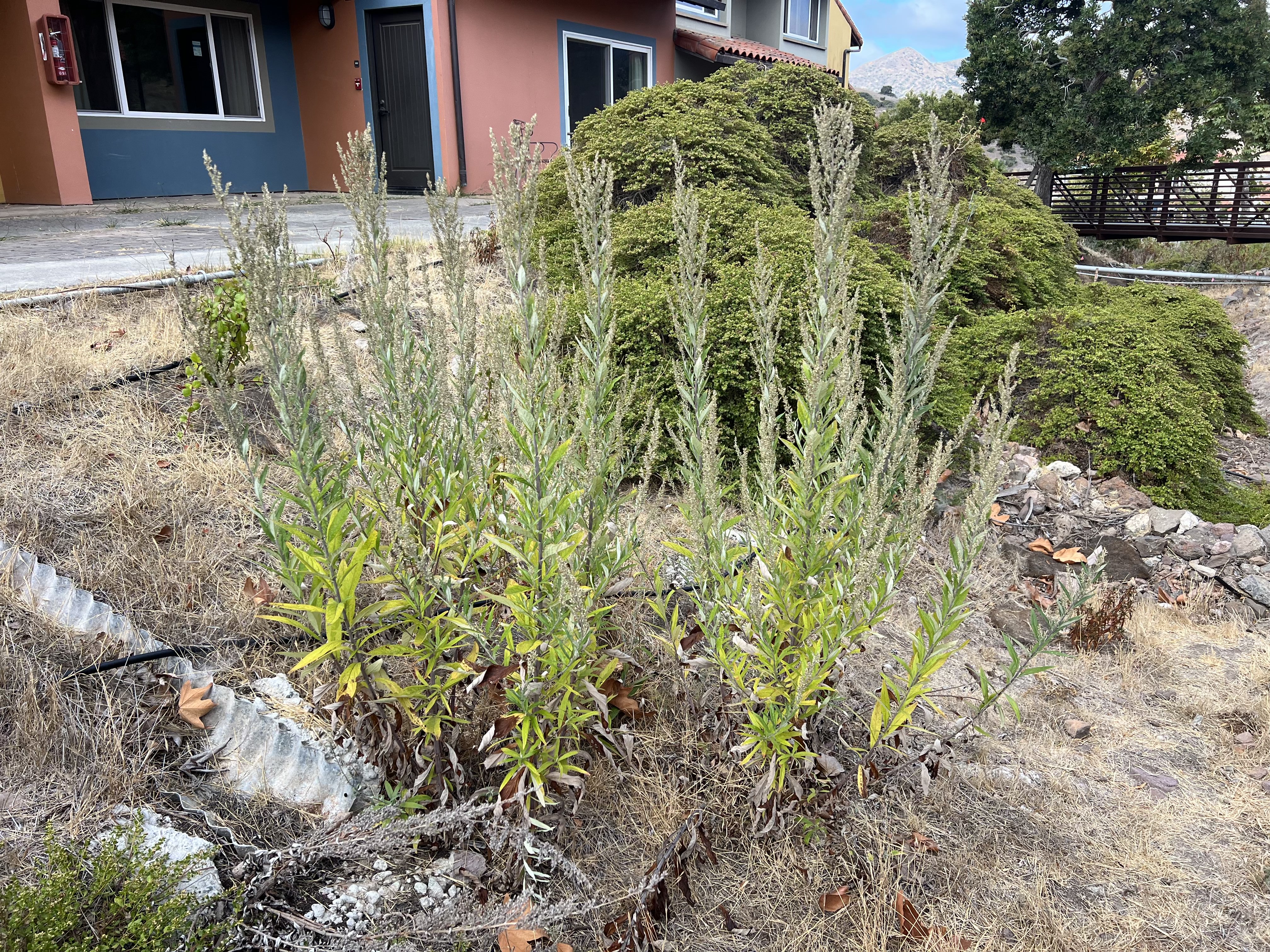
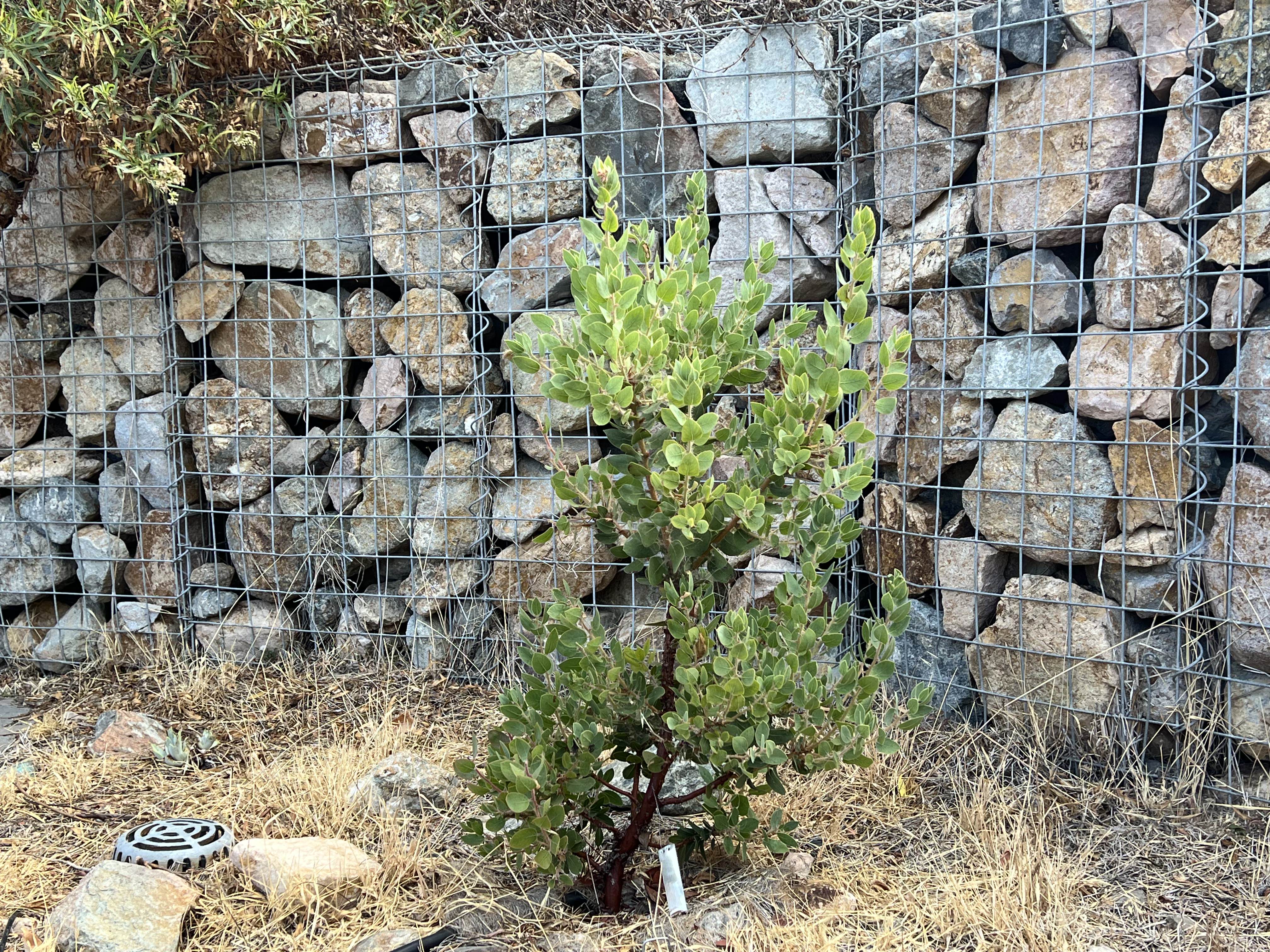

FERRY BOATS, VANS & A BIT OF MAINTENANCE
Catalina Test Plot
By Scott Applebaum and Berit Cummings
USC Environmental Studies
DATE: February 27, 2025
︎WEATHER NOTES: 58℉, overcast/mostly cloudy, with light winds up to 10 mph in the afternoon
︎PLANTS SIGHTINGS: Records of introduced and native species presence are drawn from observations during site maintenance and from records submitted to iNaturalist by students within our group.
Among the invasive species we worked to remove (and could identify) were:
| Atriplex semibaccata | Australian saltbush |
| Brachypodium sylvaticum | False brome |
| Foeniculum vulgare | Fennel |
| Salsola australis | Russian thistle |
Australian saltbush was thick in higher elevations above the ravine bed in well-lit and drier areas less subject to shading from structures or ravine banks. The false brome (or other introduced grasses) was prevalent in more shaded areas including in the ravine bed, in between building structures and on north facing slopes. Substantial stands of Russian thistle occurred especially in the sunny, open area east of the bridge leading to the cafeteria. A fully grown Russian thistle that had begun to die was also removed, hopefully mitigating the threat of the invasive tumbleweed spreading its seeds.
Berit identified eight different native species using the Seek extension of iNaturalist and additional observations from other students were drawn from records in iNaturalist. Some common plants in the area included California Sagebrush, Lemonade Berry, and Narrowleaf Milkweed. Lauren Czarnec ki-Oudin told us that she had recently planted small specimens of common yarrow and verbena.
| Artemisia californica | California sagebrush |
| Asclepias fascicularis | Narrow-leaf milkweed |
| Comarostaphylis diversifolia ssp. planifolia | Summer holly |
| Baccharis pilularis | Coyote brush |
| Encelia californica | Bush sunflower |
| Artemisia douglasiana | California mugwort |
| Rhus integrifolia | Lemonade berry |
| Heteromeles arbutifolia | Toyon |
| Salvia apiana | White sage |
| Nassella pulchra | Purple needlegrass |
| Erythranthe cardinalis | Scarlet monkeyflower |
︎WILDLIFE SIGHTINGS: Wildlife sightings were limited. One student identified a Western Small Milkweed Bug (Lygaeus kalmii kalmii) in a grassy area and numerous California ground squirrels were heard and seen nearby (Otospermophilus beecheyi). While we were working within, birds moved in and out of the ravine. Ravens watched us from the eaves of the dormitory roof while smaller birds circulated through the larger trees lining the ravine margin.
︎HUMAN ACTIVITY: This visit was relatively short, and our time was primarily devoted to maintenance efforts in the of the plot including removal of invasives/weeds and watering of native plant specimens.
GENERAL NOTES: This visit brought students from the USC Environmental Studies Program to Wrigley Marine Science Center as part of the course, ENST 495 Senior Seminar (Urban Ecology). Our group (15 people total) of graduating seniors visited the site to engage activities related to course themes.
The Ms. Christie (the university-owned boat that typically transports us to and from WMSC was undergoing repairs and out of service. This necessitated that we travel on the commercial ferry boat which lands in Two Harbors (about 2 miles from the research center) and travel by van to WMSC. We are lucky to have the university boat which travels directly to and from WMSC as it dramatically expedites our travel and allows us more time on site at WMSC. The extra travel time for this trip pushed the start time of our work to the afternoon and limited our efforts to maintenance (and not allowing for additional assays of soil and biodiversity).
Nonetheless this visit was valuable for the student group both in term of hands-on experience in the restoration effort but also in providing insight and perspective that are instrumental in a project effort by these students to develop activities guides that will be helpful for engaging more WMSC visitor groups n Green Ravine activities including care and maintenance as well as assessing biodiversity over time.
SOIL and GROUND COVER: Much of the soil was also covered by grasses, with some sections living and other sections appearing dry or dead. The coir mats were generally intact and appeared to be functioning well — the plants that were surrounded by these had few or no invasives nearby, preventing the threat of crowding out the native species. However, one coir mat was stuck on a check dam, so this was perhaps washed away during a recent storm event.
SOIL MOISTURE: The soil was moderately dry as we worked during our visit which occurred approximately two weeks after the first rain event of the season. There was not significant evidence of erosion, though sediment, leaves, and other organic material could be seen accumulated on the upstream side of the check dams.
Since summer of 2024, we have been experimenting with automated soil sensors that can log soil moisture and temperature over time. These not only give us a high-resolution time series of soil moisture daily to seasonally but also may be useful in assessing the soil moisture retention properties as the restoration and enhancement of the ravine continues (Figure 1).
SUMMARY: The two components of the Green Ravine that stood out to me (Berit) were 1) the difficulty of native plant restoration and 2) the link between runoff water quality and terrestrial ecosystem health. I was surprised to see that despite all the efforts that have been put into this test plot, there were still a ton of invasives for us to remove. I had not previously considered how native plant restoration goes well beyond the initial planting — these plants also need to be protected and kept up, as the invasives will inevitably emerge again. Another part of the Green Ravine restoration effort that stood out to me was the linkage with water quality management. It was interesting to see how water quality Best Management Practices (BMPs) have been integrated into the Green Ravine and how water quality and native plant restoration go hand in hand. These two areas of ecological improvement are so complimentary, and I hope that water-stressed places like Los Angeles will take advantage of how we can fix these two issues side by side.
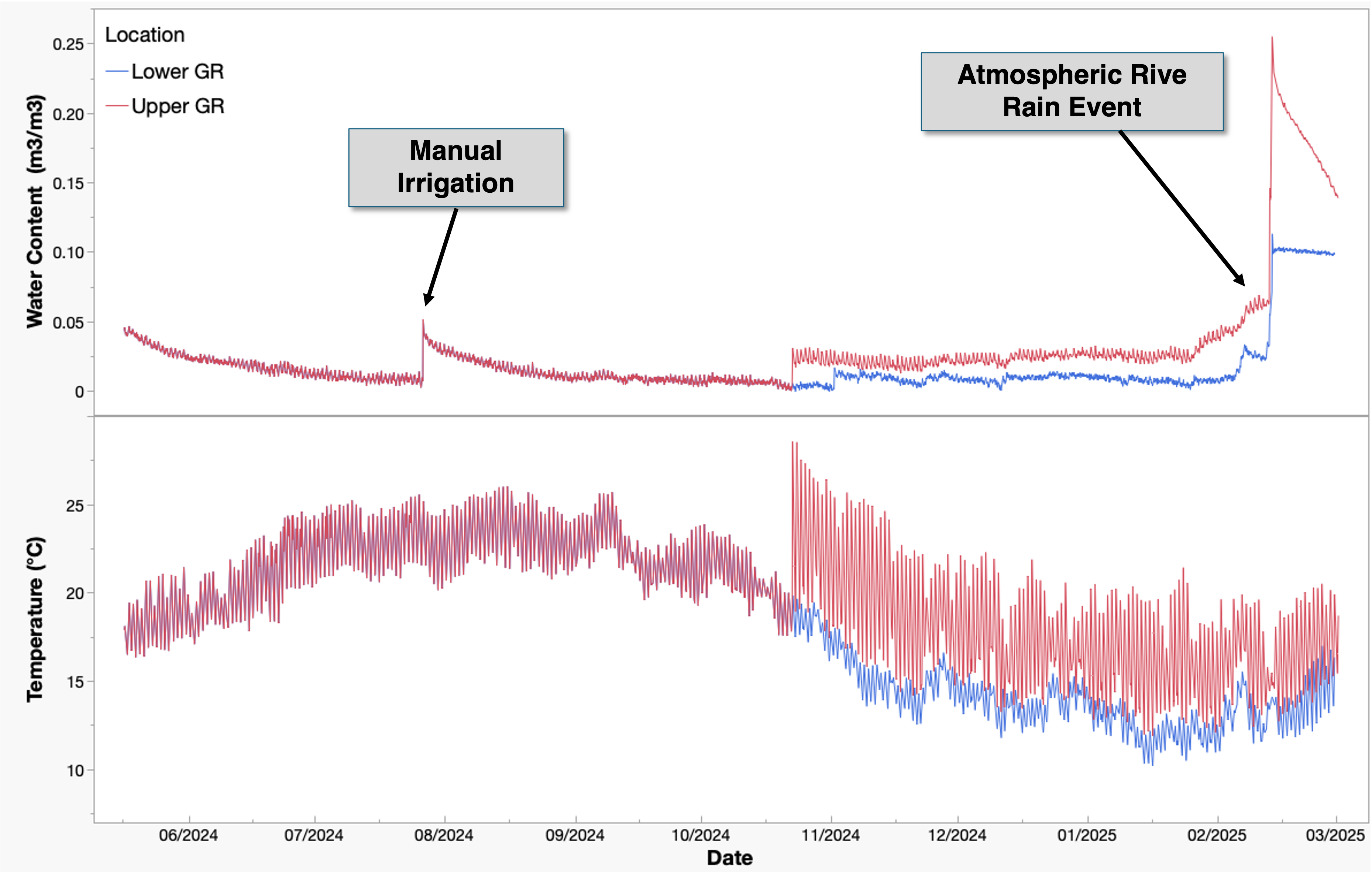
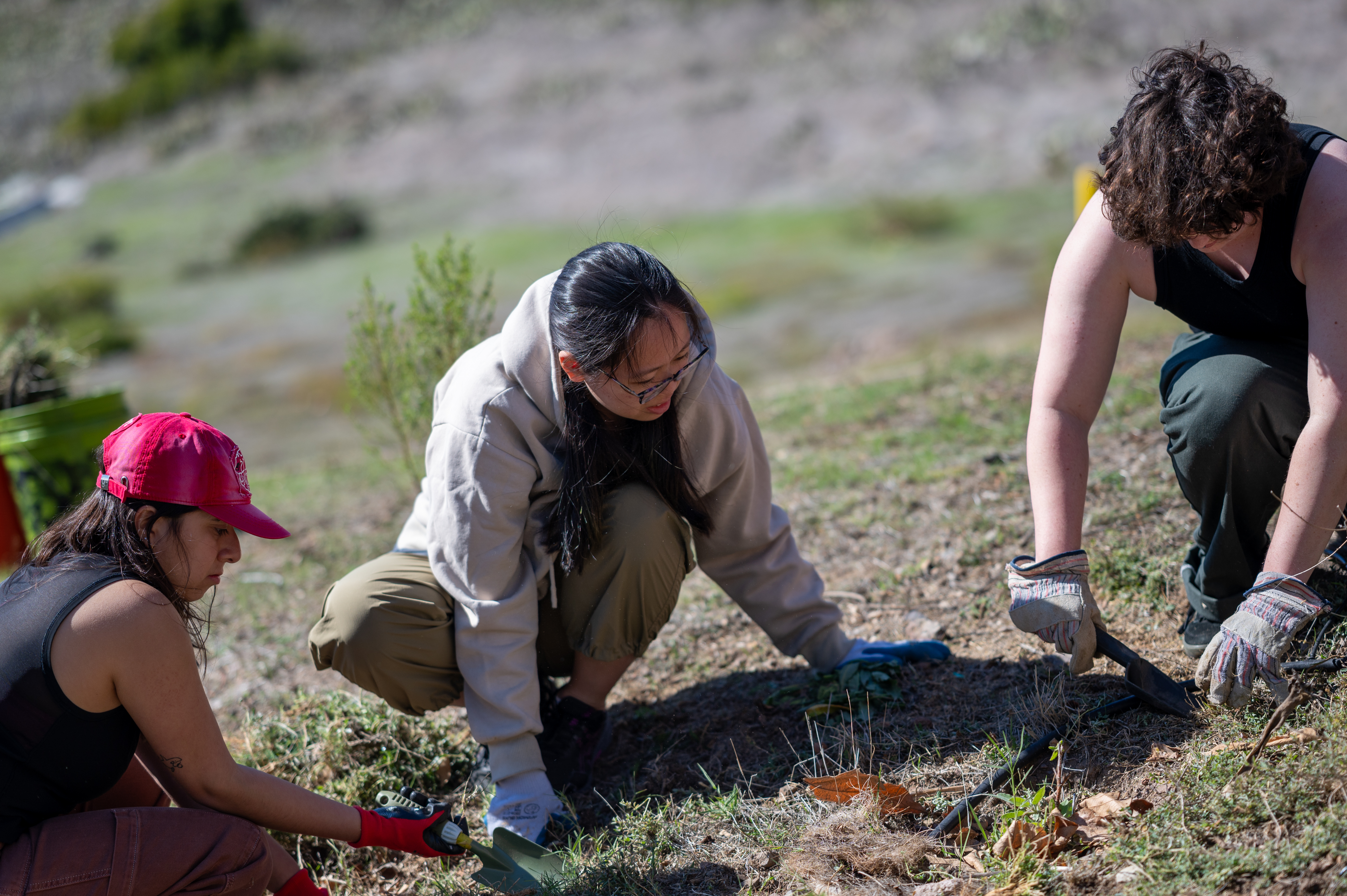
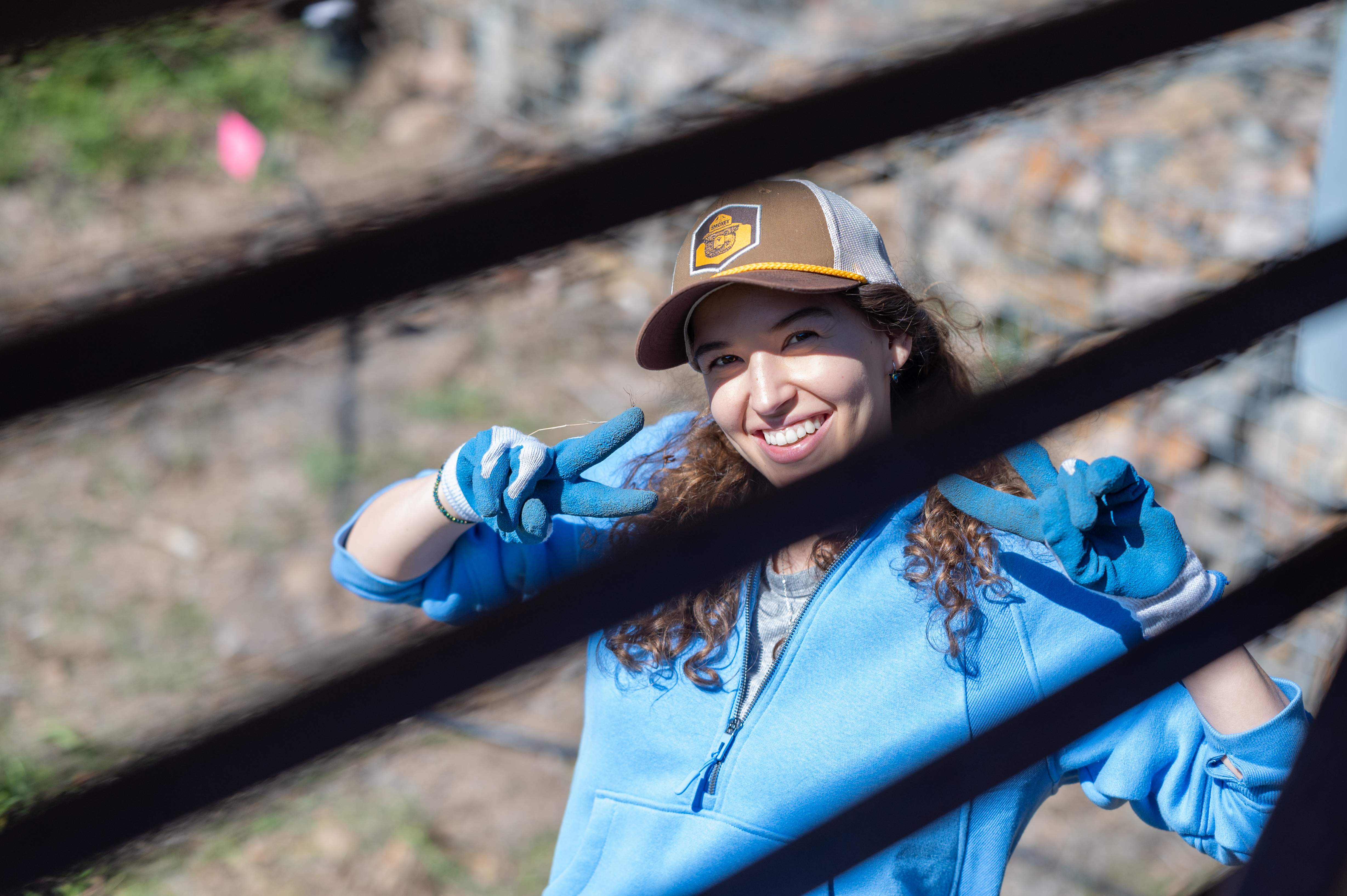
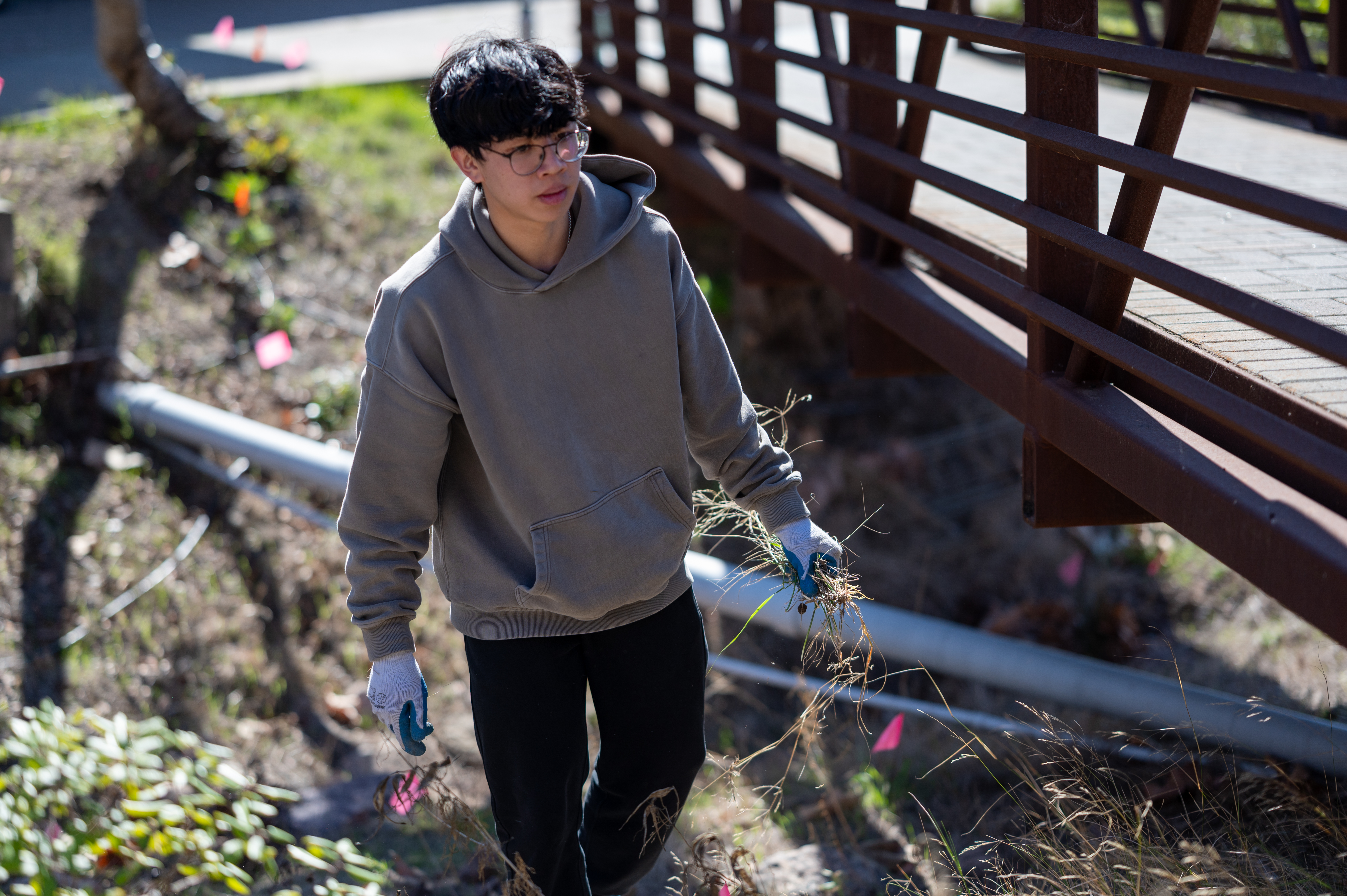





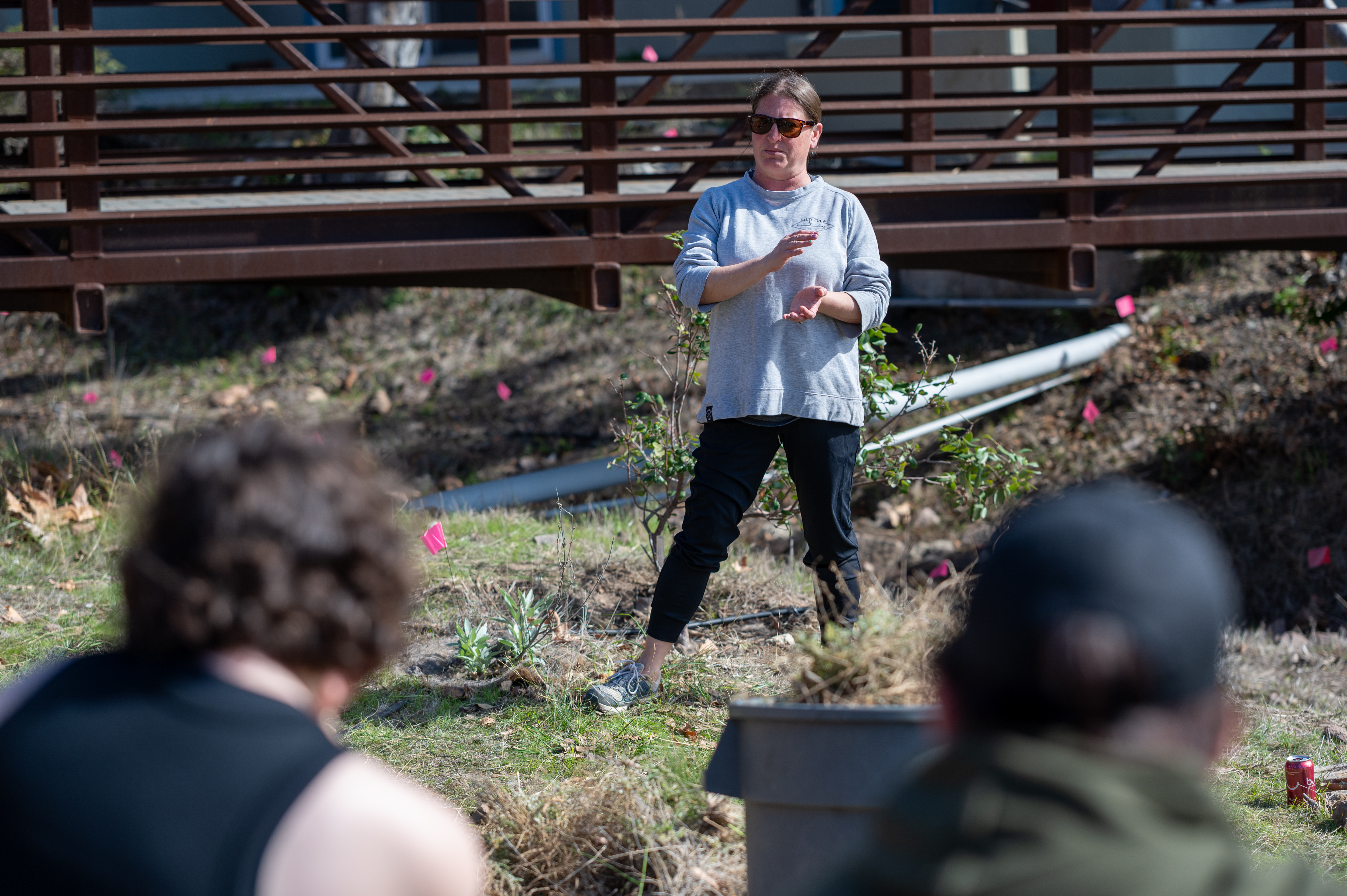
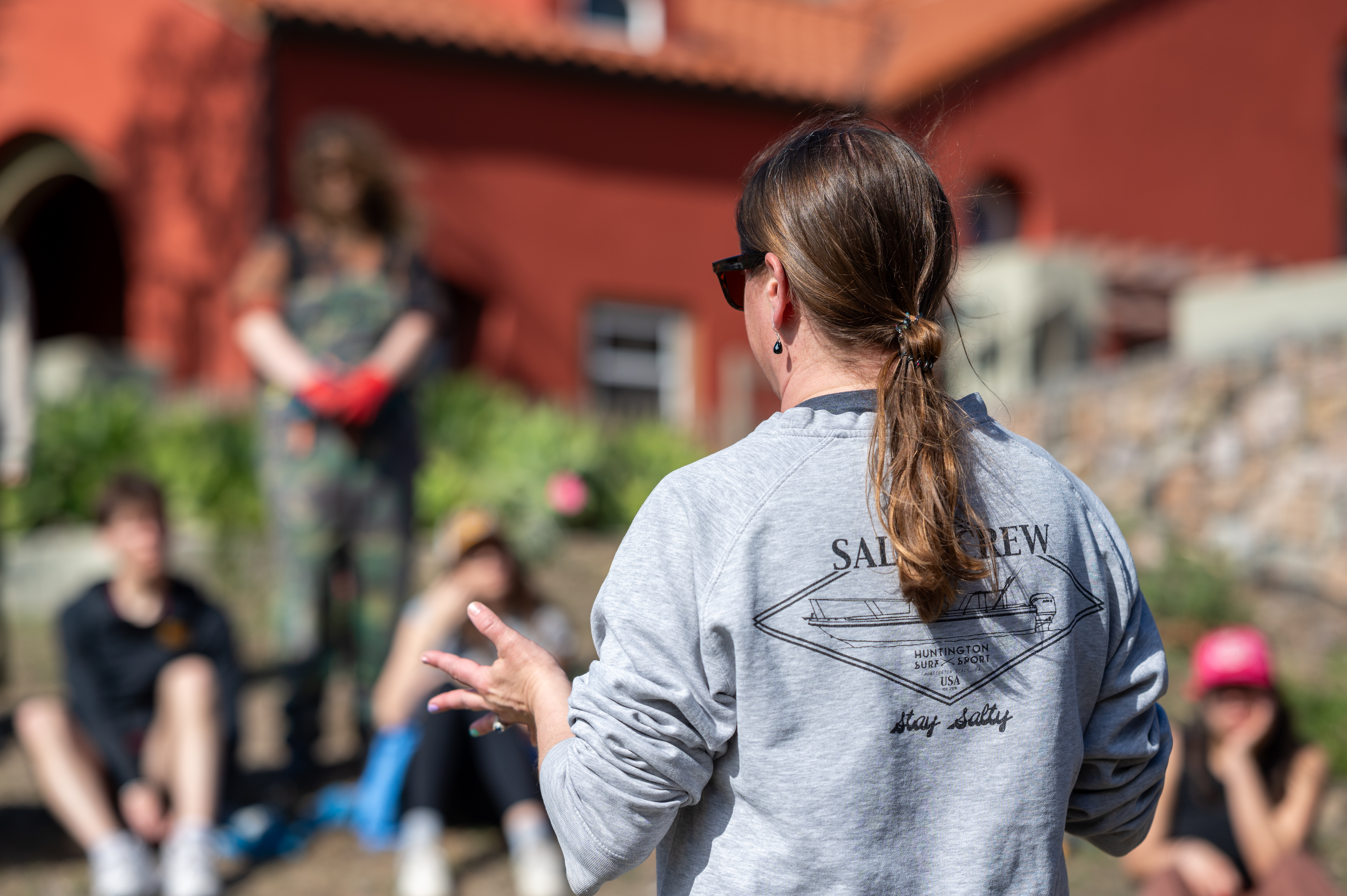


GREEN RAVINE @ CATALINA TURNS 1!
Catalina Island Test Plot
By Alex Robinson
USC Department of Landscape Architecture & Urbanism
DATE: Oct 22 2024
SOIL MOISTURE: Dry
︎ PLANT SIGHTINGS:
Out of the 174 plants planted one year ago (Nov 2023), about 30 have perished according to Lauren Czarnecki, the Test Plot lead steward of Catalina. Reasons include lack of water (see notes on irrigation system below), browsing by ground squirrels (esp loved wooly sunflower and don’t like golden yarrow) and transplant shock. Endemic species include Wallace’s nightshade, Catalina ironwood (not Santa Cruz which is more popular on the mainland), Mountain mahogany, Island Ceanothus, and the Catalina Island Manzanita. They are all surviving!
WEED SIGHTINGS:
We were lucky to be joined by a team from the Catalina Conservancy Invasive Plant Management team joined our group. Aaron Kreisberg, Plant Conservation Manager, walked the ravine and identified the major weeds, which were all located on the western edge of the plot.
They included:
He also suggested this amazing resource WEEDRIC (Research & Information Center) by UC Davis which lists invasive species A-Z and offers management strategies. He says he uses it every day!
︎WILDLIFE SIGHTINGS: None in the immediate plot area except a wicked spider web.
HUMAN ACTIVITY: Our team consisted of USC students from Alex’s class, Tawny de Guzman from Community Nature Connection plus 2 colleagues, Julio Soria from LA Nature for All, and Scott Applebaum from the ENST program. We weeded the ravine, planted 30 new plants, and gave the existing and new plants a deep water.
“ My favorite part of the day was when we got to dig holes for some replacement plants in the ravine. Some areas were very easy to dig down into whereas others were quite rocky and dry, so it was great to see our group really begin to cooperate more and work together on the harder spots. I also enjoyed locating a Dudleya that was hiding underneath some Encelia californica, and pruned back the shrub to provide more sunlight. “ - Mark Reid, USC Student
GENERAL NOTES: It was a beautiful day, with multiple dolphin and gray whale sightings on the boat ride there and back. Lauren has been an amazing steward over the last year, but watering is challenging and time consuming. She has been underwatering the plants (twice in the fall and spring and 3-4 times over the summer). The IBC tote (250 gallons of collected rainwater) was placed upstream and gravity feeds into 4 drip irrigation lines, with 1 emitter covering each plant (at least most plants). However it turns out the head pressure is only great enough to run one line (the top one) so the plants towards the bottom of the swale did not receive as much water. It takes several hours to drain one tote, and requires machinery to replace the totes. It is also tricky to find time to water during the cooler times of day. She learned a trick to spray the water to create more humidity, which helps against the dry Santa Annas.
SOIL: Scott Applebaum’s class spent time over the summer, and conducted more soil tests to compare with those taken in September 2023 (see LOG POST HERE). They found that the soil cores are shifting away from clay to include more silt.
COIR MATS: This is the first time we tried coir mats, and they are all still holding their form and intact. Lauren’s thoughts are that they have helped with water retention in the dry months. She noticed that if they were not staked down very well, they would rip and pull the plants away during winter when the ravine had active water flow.
TIMELAPSE: The Chronolog has been up and running since July. It’s a community science app that takes photos that people can upload and creates a timelapse video.
SUMMARY: Lauren reminded us the goal is 3 S’s : slow the water, spread it, and sink it. The rock check dams are working, and she observed standing water in July, which allows for species like the Baja Choir Frog to visit through June.
Catalina Island Test Plot
By Alex Robinson
USC Department of Landscape Architecture & Urbanism
DATE: Oct 22 2024
TIME: 10AM-2PM
TEMP: 73 F
︎
WEATHER: Sunny, Blue Skies, Warm
WIND (SPEED/DIRECTION): Not noticeableSOIL MOISTURE: Dry
︎ PLANT SIGHTINGS:
Out of the 174 plants planted one year ago (Nov 2023), about 30 have perished according to Lauren Czarnecki, the Test Plot lead steward of Catalina. Reasons include lack of water (see notes on irrigation system below), browsing by ground squirrels (esp loved wooly sunflower and don’t like golden yarrow) and transplant shock. Endemic species include Wallace’s nightshade, Catalina ironwood (not Santa Cruz which is more popular on the mainland), Mountain mahogany, Island Ceanothus, and the Catalina Island Manzanita. They are all surviving!
WEED SIGHTINGS:
We were lucky to be joined by a team from the Catalina Conservancy Invasive Plant Management team joined our group. Aaron Kreisberg, Plant Conservation Manager, walked the ravine and identified the major weeds, which were all located on the western edge of the plot.
They included:
| Atriplex semibaccata | Australian saltbush |
| Brachypodium sylvaticum | False brome |
| Brassica nigra | Black mustard |
| Bromus diandrus | Ripgut brome |
| Bromus hordeaceus | Soft brome |
| Centaurea melitensis | Maltese star thistle |
| Cynodon dactylon | Bermuda grass |
| Erigeron canadensis | Horseweed |
| Foeniculum vulgare | Fennel |
| Rumex crispus | Curly Dock |
| Salsola australis | Russian thistle |
| Salsola tragus | Russian tumbleweed |
| Stipa miliacea | Smilograss |
He also suggested this amazing resource WEEDRIC (Research & Information Center) by UC Davis which lists invasive species A-Z and offers management strategies. He says he uses it every day!
︎WILDLIFE SIGHTINGS: None in the immediate plot area except a wicked spider web.
HUMAN ACTIVITY: Our team consisted of USC students from Alex’s class, Tawny de Guzman from Community Nature Connection plus 2 colleagues, Julio Soria from LA Nature for All, and Scott Applebaum from the ENST program. We weeded the ravine, planted 30 new plants, and gave the existing and new plants a deep water.
“ My favorite part of the day was when we got to dig holes for some replacement plants in the ravine. Some areas were very easy to dig down into whereas others were quite rocky and dry, so it was great to see our group really begin to cooperate more and work together on the harder spots. I also enjoyed locating a Dudleya that was hiding underneath some Encelia californica, and pruned back the shrub to provide more sunlight. “ - Mark Reid, USC Student
GENERAL NOTES: It was a beautiful day, with multiple dolphin and gray whale sightings on the boat ride there and back. Lauren has been an amazing steward over the last year, but watering is challenging and time consuming. She has been underwatering the plants (twice in the fall and spring and 3-4 times over the summer). The IBC tote (250 gallons of collected rainwater) was placed upstream and gravity feeds into 4 drip irrigation lines, with 1 emitter covering each plant (at least most plants). However it turns out the head pressure is only great enough to run one line (the top one) so the plants towards the bottom of the swale did not receive as much water. It takes several hours to drain one tote, and requires machinery to replace the totes. It is also tricky to find time to water during the cooler times of day. She learned a trick to spray the water to create more humidity, which helps against the dry Santa Annas.
SOIL: Scott Applebaum’s class spent time over the summer, and conducted more soil tests to compare with those taken in September 2023 (see LOG POST HERE). They found that the soil cores are shifting away from clay to include more silt.
COIR MATS: This is the first time we tried coir mats, and they are all still holding their form and intact. Lauren’s thoughts are that they have helped with water retention in the dry months. She noticed that if they were not staked down very well, they would rip and pull the plants away during winter when the ravine had active water flow.
TIMELAPSE: The Chronolog has been up and running since July. It’s a community science app that takes photos that people can upload and creates a timelapse video.
SUMMARY: Lauren reminded us the goal is 3 S’s : slow the water, spread it, and sink it. The rock check dams are working, and she observed standing water in July, which allows for species like the Baja Choir Frog to visit through June.
CATALINA SOIL TEST #1
Green Ravine Test Plot
Q&A by Jen Toy with Emersyn Klick and Alia Harris
Environmental Studies undergraduate students at USC
Date: September 19 2023
Jen: Can you please start by introducing yourselves?
Emersyn: My name is Emersyn and I’m a junior Business Administration major with a minor in Environmental Studies at USC. I’m from Northern California and my hobbies include dancing and hiking.
Alia: My name is Alia and I’m a sophomore studying mechanical engineering with a minor in environmental studies at USC. I’m from Oregon and I play basketball, make jewelry, and I love doing anything outside.
Green Ravine Test Plot
Q&A by Jen Toy with Emersyn Klick and Alia Harris
Environmental Studies undergraduate students at USC
Date: September 19 2023
Jen: Can you please start by introducing yourselves?
Emersyn: My name is Emersyn and I’m a junior Business Administration major with a minor in Environmental Studies at USC. I’m from Northern California and my hobbies include dancing and hiking.
Alia: My name is Alia and I’m a sophomore studying mechanical engineering with a minor in environmental studies at USC. I’m from Oregon and I play basketball, make jewelry, and I love doing anything outside.
Emersyn: Catalina Island has a very similar feel to much of California’s natural landscape with a chaparral environment, but with some unique wildlife and a serenity that is unlike the mainland. Because much of the island is part of the Catalina Island Conservatory or a Marine Protected Area, you become immersed with the wildlife. Outside of Avalon, it feels rather remote on the island, in the best way possible, despite being only 22 miles from California’s mainland.
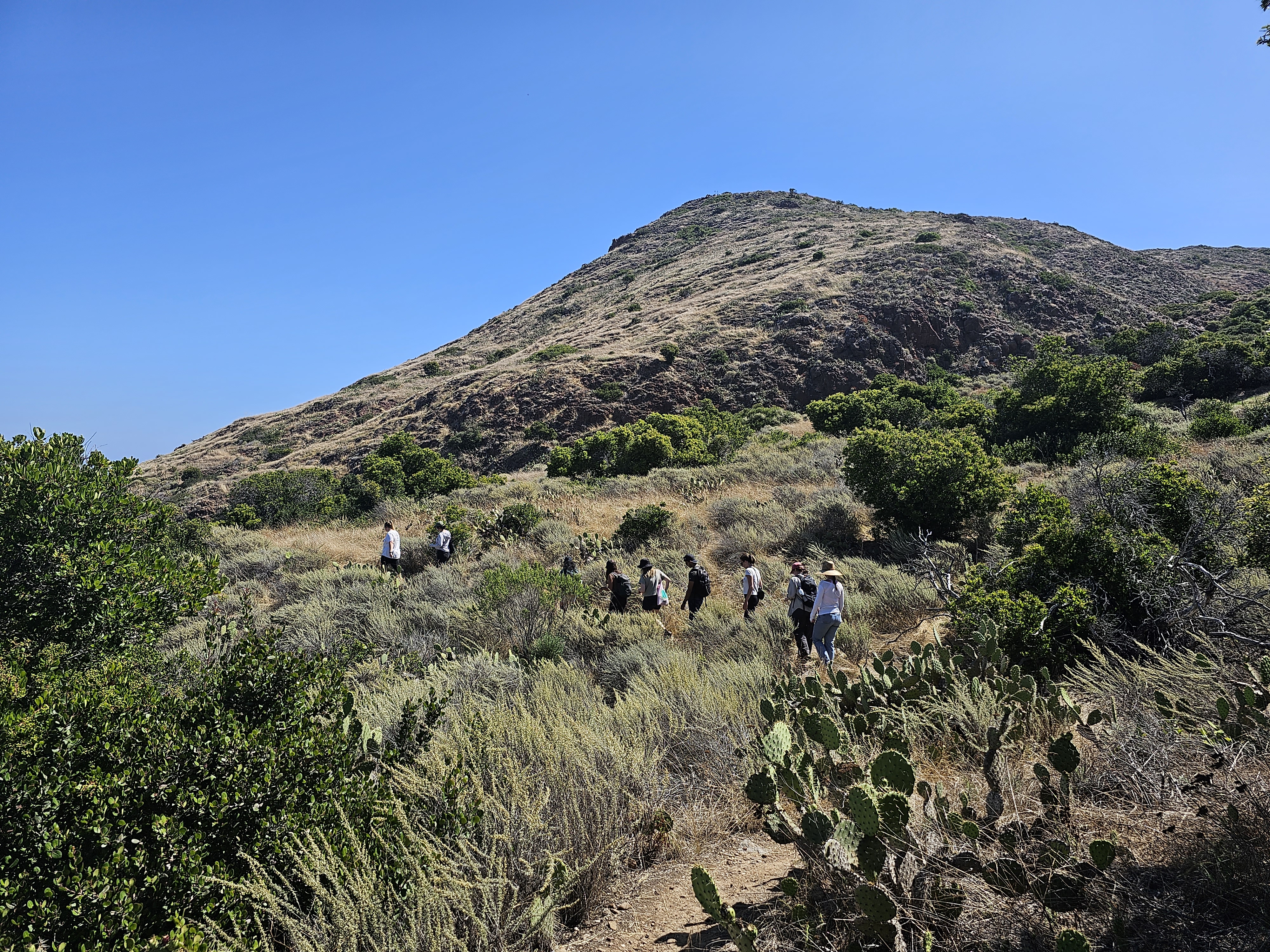
Jen: Can you describe the Green Ravine? Where does it sit on the island? What is the ecosystem? How does it relate to the Wrigley Campus?
Emersyn: The Green Ravine is part of one of the lowermost sections of a watershed, located on the USC Wrigley Institute outside of the dorm style housing. A watershed is an area bound by ridges in the land above where water falls and converges to one point. More generally, the Wrigley Institute is located in Big Fisherman Cove near the town of Two Harbors. The ecosystem on the Island is of a chaparral biome, meaning that it has hot, dry summers with mild, rainy winters, creating an overall arid landscape with many native drought resistant shrubs. At the time of our data collection, the Green Ravine had a mix of both native and invasive plant species.
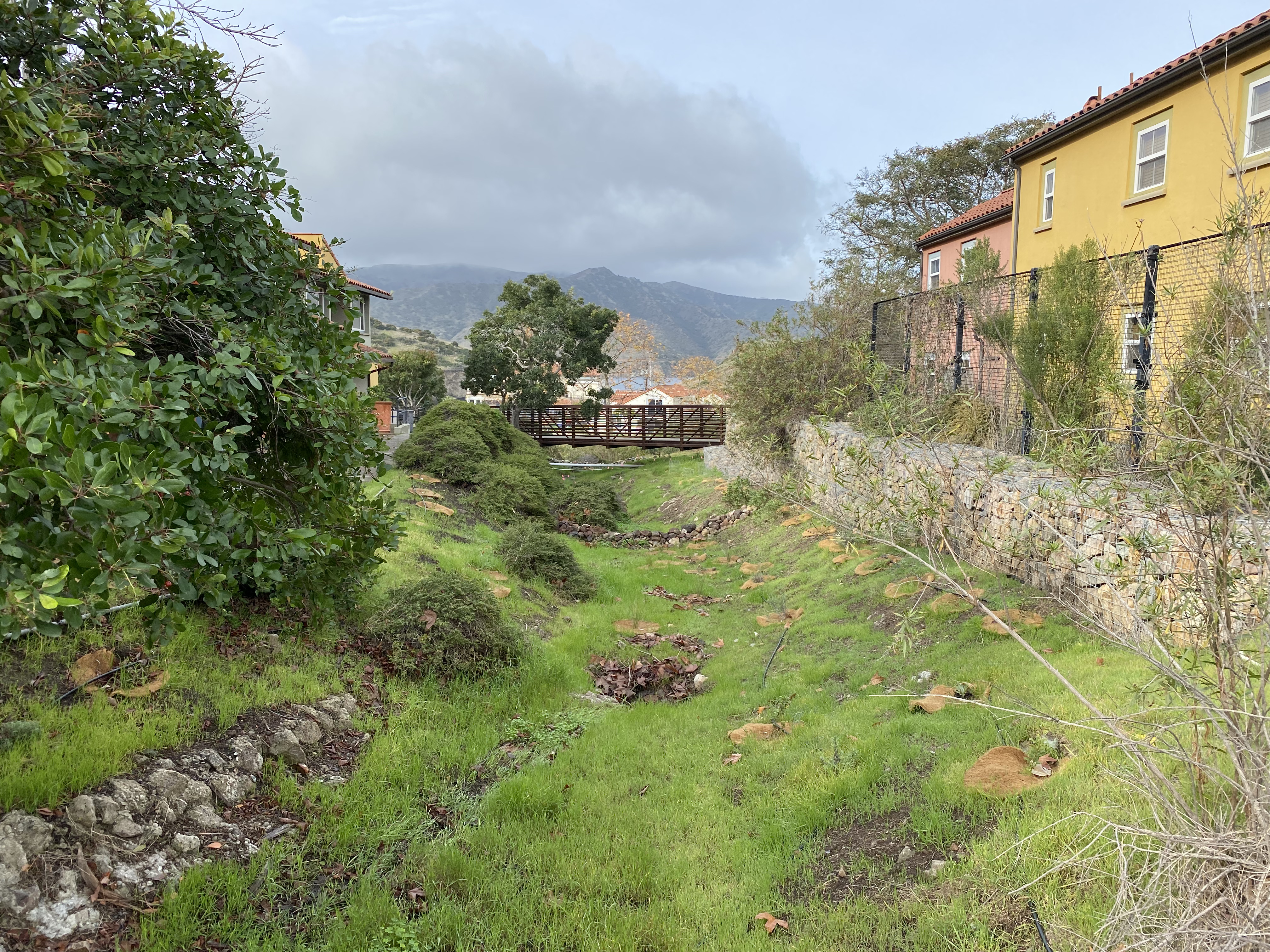
Jen: What were your objectives in taking soil samples?
Alia: When taking soil samples, we had the objective of determining whether or not the soil would support a restoration of native plants, and if there would be anything that would be needed to be done to it in order to support more lush plant life. We wanted to assess the current health of the soil. This would set a baseline for comparison after native plants were put into the area. It would also help us understand the conditions of the surrounding watershed in addition to the green ravine. When we took samples, we had to take them in a mostly random distribution because the area is so rocky, and we had trouble getting our equipment to penetrate the ground in a lot of places.
Jen: Can you describe what did the soil look and feel like?
Emersyn: Depending on where the soil sample was taken, the soil was either dry and crumbly or dry and compacted, making it easy to take some of the samples while a few were quite difficult. Within the samples, there was gravel and small rocks and the soil particles themselves appeared large. Due to the presence of rocks and/or plants throughout the test plot, the samples were taken in a mainly random pattern wherever it was feasible. When breaking up the soil with a mortar and pestle to be able to sift it, many of the particles were tightly bound in small clumps.
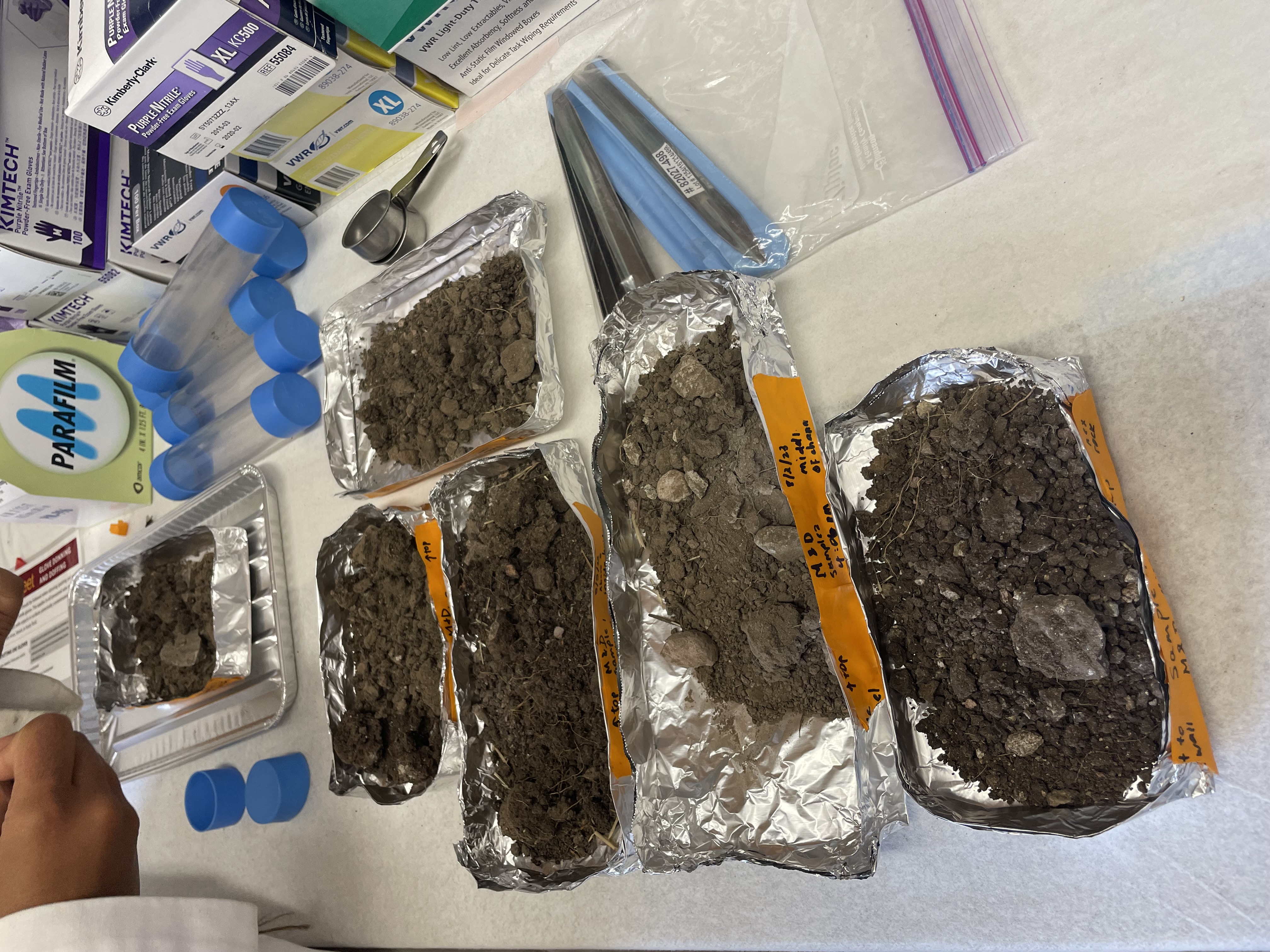
Jen: What soil properties did you examine? Why is each one important?
Alia: The soil properties we examined were soil composition, soil texture, nutrient content and pH, bulk density, porosity and water content, respiration, and conductivity.
-
Soil composition tells us how much of the soil is solution, how much is air, how much is organic matter, and how much is minerals. This lets us know how well the soil can hold and provide nutrients for plants.
-
Soil texture is basically a measure of the composition of the mineral portion of the sand, so it reveals the content of sand, silt, and clay in the mineral part of the soil. This measurement gives us insight into how well the soil will hold water.
-
Nutrient content and pH are two characteristics of soil that are very important when discussing plant growth because plants need a balanced pH as well as a certain level of nutrients present in the soil to be able to thrive. Bulk density, porosity, and water content are all aspects of soil compaction and moisture, so they may affect the root growth of plants and how far into the soil those roots are able to reach.
-
Soil respiration is measured by the amount of oxygen released from soil over a given time period. This measurement is used as an indicator of microbial activity, so it can give us an indication of whether or not there are a lot of microorganisms at work in the soil.
-
Lastly, we measured the electrical conductivity of the soil. This is important because the thing that helps soil be a good conductor is salt content, so conductivity tells us if the soil has a high salt content that could be damaging to plants.
Jen: Is there any special equipment you need to perform these tests? Are there any of these tests that people can do at home?
Emersyn: Many of the tests we conducted can be done at home with some simple tools. To collect soil samples, we used soil core samplers to collect a precise amount of soil and to maintain the condition of the soil; however, a soil sampler probe could be used to collect samples as well. Testing for pH, nitrogen, phosphorus, and potassium are the easiest tests to do at home using a Rapitest soil test kit. To weigh the samples in bulk density, porosity, and water content measurements, a scale is needed as well as an oven. To measure soil texture, a sift, mortar and pestle, graduated cylinder, water, sodium hexametaphosphate, thermometer, timer, and hydrometer are needed. Other helpful tools include a hand shovel, a pen and tape for labeling, and tin foil. Tests for organic matter would require an oven that can reach 450℃, respiration tests would require a CO2 indicator, and salinity tests would require a soil EC meter, therefore these tests would be difficult to conduct at home.
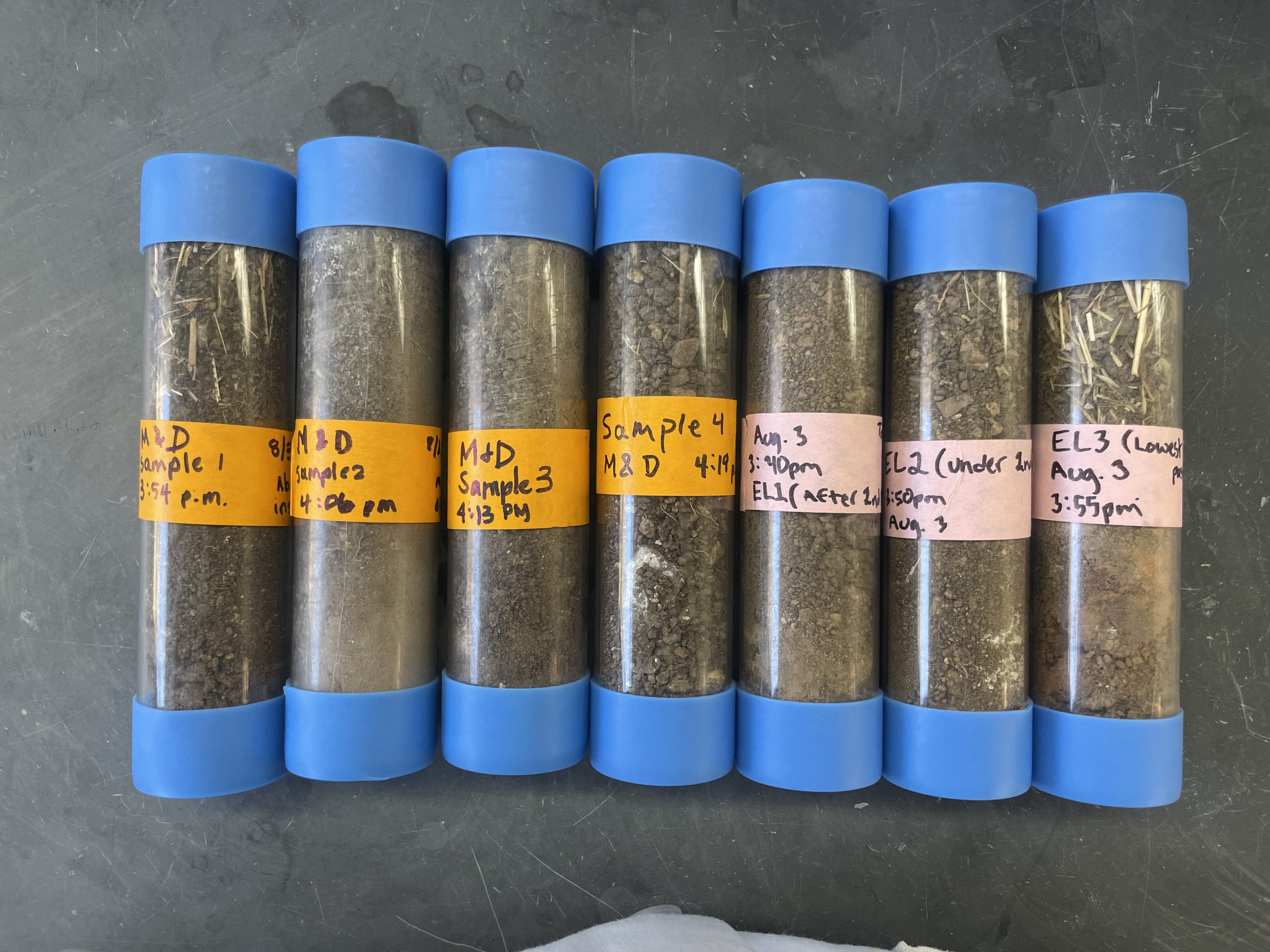
Jen: How would you describe the soils in the Green Ravine?
Alia: The soil in the green ravine is very porous, it’s dry, and it has a low nutrient content. The main aspect of this soil that makes it unique is the fact that it is almost entirely newly settled sediment, so it is very loose soil. It falls in the bottom of a channel through which water that is often carrying a lot of sediment flows, which describes its low compaction. Its low water content and lack of nutrients may sound concerning, but they are not actually a bad thing. This is typical of this biome which means that the soil in the green ravine is very normal for a chaparral biome in all of its other aspects. It has coarse grain size because it is considered a sandy loam based on our soil texture data, which basically means that it has a lot of sand and a lot of silt, and not very much of it is clay which is the smallest soil particle. Overall, the green ravine soil looks like a loose, less compact version of healthy chaparral biome soil.
Jen: What were the results and takeaways?
Emersyn: The breakdown of soil components was 45.47% air, 42.54% mineral, 8.24% solution, and 3.75% organic matter.
-
The soil’s texture was overall a sandy loam composed of 65% sand, 18% silt, and 16% clay. This composition allows for good drainage of water, which is beneficial for the Green Ravine where one of the goals is to allow the water to infiltrate and percolate through the soil.
-
The average bulk density was 1.0742g/cm^3, and while this was low, it still indicates overall good soil health.
-
The average pH was 6.8, which falls within the ideal pH range for many native plants in the area. The soil was depleted in nitrogen, phosphorus, and potassium indicating a low cation exchange capacity, which is normal and expected for the environment as the tests used are designed for agricultural fields where levels are anticipated to be higher.
-
All the soil samples had a high concentration of CO2 possibly due to the Birch Effect, where the sudden addition of water to dry soil with typically limited water levels, causes a short-term spike of CO2 output with higher microbial respiration and activity levels.
-
Finally, the soil was non-saline. The conductivity of the soil was 0.17dS/m, while the USDA defines saline soil as being higher than 1dS/m.
Taking all our measurements into consideration, a few takeaways could be made. Firstly, as Alia mentioned, the soil is typical of its biome. The arid landscape of a chaparral biome creates soils that have high porosity, are nutrient-poor, dry, and have a coarse grain size, all of which were observed in our soil samples. So while these conditions aren’t necessarily ideal for agricultural production, we concluded that native plants will likely do well as they have been well adapted to thrive in this type of soil. This was great news because it meant that the Test Plot was suitable for the restoration that would be taking place in the following months. Secondly, there weren’t any large differences between the soils taken before and after the two check dams in the Green Ravine, which was likely due to our distribution and random choice in sample location. To properly assess how well the check dams work, more samples right before and after each should be taken in the future. Lastly, the lower bulk density of the soil had to do in part because most of our soil samples were taken within the part of the Green Ravine where the water stream was flowing, therefore there was less organic matter and plant growth in that area. Additionally, with a large amount of rain from this past winter, sediment from upstream had recently been displaced and loosely consolidated in that part of the ravine as well, making it less compact than soil in a field would be.

